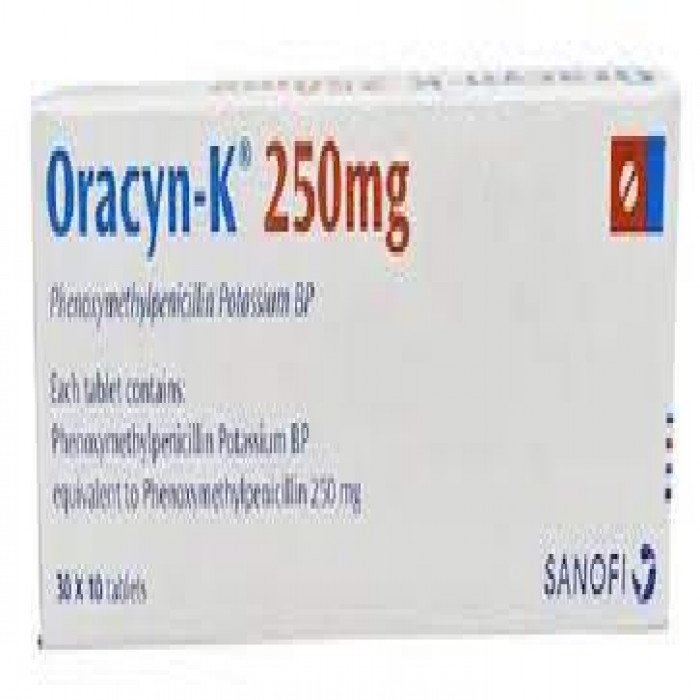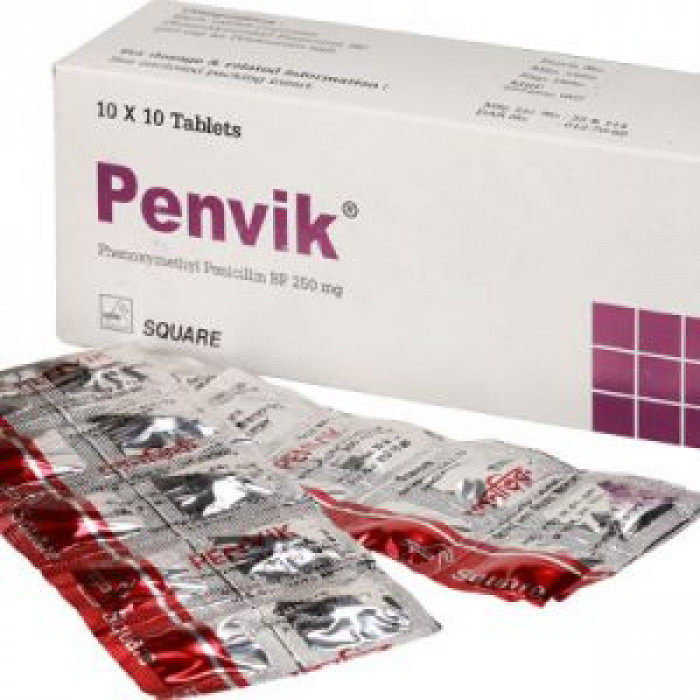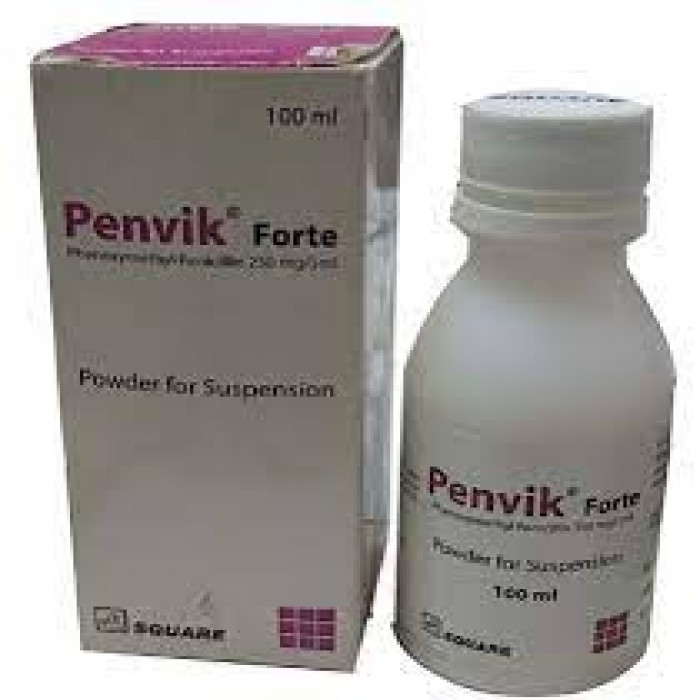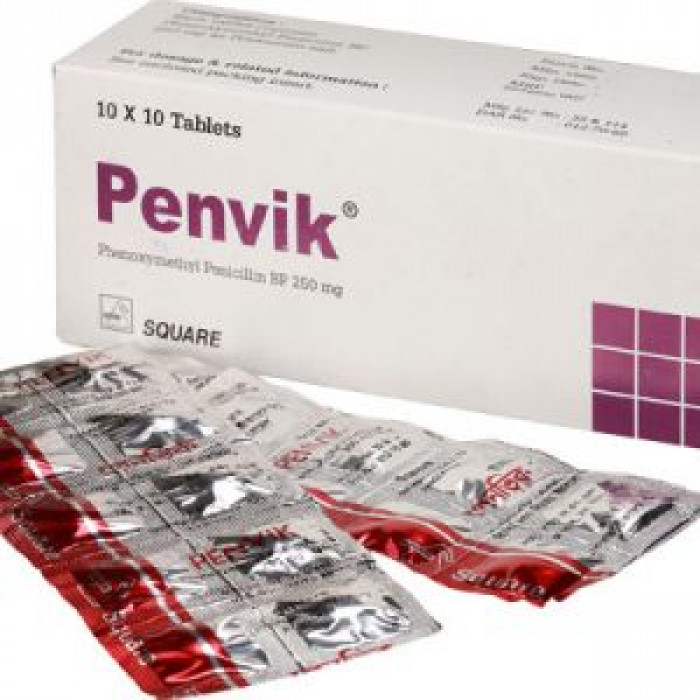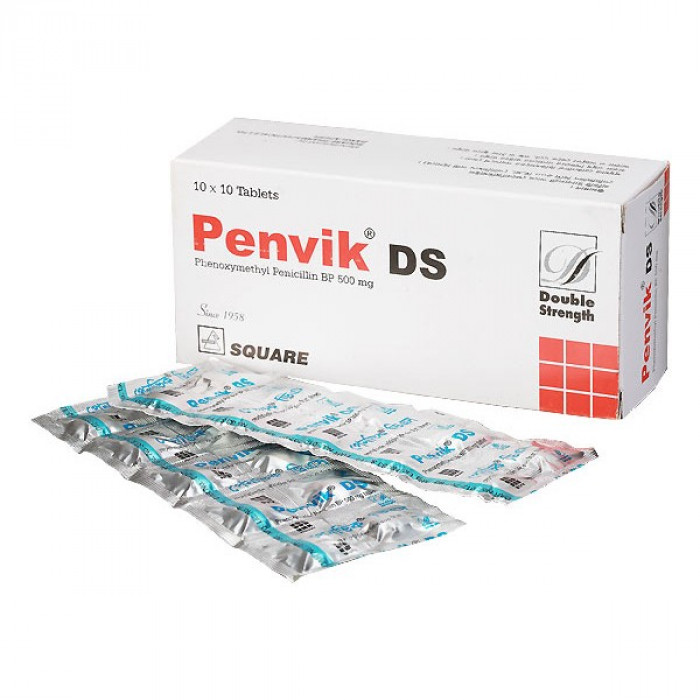
✔ 100% Authentic Product
👁️ Currently Viewing 7716
Penvik DS 500mg Tablet
Phenoxymethyl Penicillin [Penicillin V] is used in the treatment of Bacterial Infections and Syphilis.
Discount
Price: ৳ 52
MRP:
৳
55
5%
Off

100% Genuine Products, Guaranteed

Safe & Secure Payments, Always

Fast, Secure & Efficient Delivery

Proper Packaging
 Cash on Delivery - All over Bangladesh
Cash on Delivery - All over Bangladesh Regular Delivery - 12-24 Hours, Dhaka City* Charge Tk.39-59
Regular Delivery - 12-24 Hours, Dhaka City* Charge Tk.39-59 Regular Delivery - 24-48 Hours, Other Cities* Charge Tk.99-110
Regular Delivery - 24-48 Hours, Other Cities* Charge Tk.99-110
 ফ্রি ডেলিভারিঃ - ৯৯৯ টাকা+ অর্ডারে, ঢাকা
শহরে
ফ্রি ডেলিভারিঃ - ৯৯৯ টাকা+ অর্ডারে, ঢাকা
শহরে ফ্রি ডেলিভারিঃ - ২৯৯৯ টাকা+ অর্ডারে, ঢাকার
বাহিরে
ফ্রি ডেলিভারিঃ - ২৯৯৯ টাকা+ অর্ডারে, ঢাকার
বাহিরে
100% Genuine Products, Guaranteed
Safe & Secure Payments, Always
Fast, Secure & Efficient Delivery
Proper Packaging
 Cash on Delivery - All over Bangladesh
Cash on Delivery - All over Bangladesh Regular Delivery - 12-24 Hours, Dhaka City* Charge Tk.39-59
Regular Delivery - 12-24 Hours, Dhaka City* Charge Tk.39-59 Regular Delivery - 24-48 Hours, Other Cities* Charge Tk.99-110
Regular Delivery - 24-48 Hours, Other Cities* Charge Tk.99-110 ফ্রি ডেলিভারিঃ - ৯৯৯ টাকা+ অর্ডারে, ঢাকা
শহরে
ফ্রি ডেলিভারিঃ - ৯৯৯ টাকা+ অর্ডারে, ঢাকা
শহরে ফ্রি ডেলিভারিঃ - ২৯৯৯ টাকা+ অর্ডারে, ঢাকার
বাহিরে
ফ্রি ডেলিভারিঃ - ২৯৯৯ টাকা+ অর্ডারে, ঢাকার
বাহিরে
✅ Description:
Penvik DS 500mg Tablet (Phenoxymethyl Penicillin, also known as penicillin V), is an antibiotic commonly used to treat various bacterial infections. Here are some important points about phenoxymethylpenicillin:
Phenoxymethylpenicillin belongs to the penicillin and beta-lactam family of antibiotics. It works by inhibiting the formation of the bacterial cell wall, leading to the death of susceptible bacteria. Phenoxymethylpenicillin is effective in treating infections caused by Streptococcus pyogenes, including tonsillitis, pharyngitis (sore throat), and skin infections. It can also be used for the primary and secondary prevention of rheumatic fever. In certain cases, it may be used for mild uncomplicated anthrax infections or early-stage Lyme disease in pregnant women or young children.
Phenoxymethylpenicillin is taken orally, typically in the form of tablets or suspension. It is absorbed through the digestive system.
Safety Advices

Alcohol
UNSAFE
You should avoid consuming alcohol while on treatment with Penvik DS, 500mg Tablet as alcohol is known to worsen the infection.

Pregnancy
CONSULT YOUR DOCTOR
There is limited information about the effects of the Penvik DS 500mg Tablet on pregnancy, thus you should avoid taking this medicine unless advised by your doctor.

Breastfeeding
CONSULT YOUR DOCTOR
It is unknown if this medicine passes into breast milk, hence you should consult your doctor before using Penvik DS 500mg Tablet while breastfeeding.

Driving
CAUTION
Penvik DS 500mg Tablet has no or negligible influence on your ability to drive.

Kidney
CAUTION
If you have any history of kidney diseases before taking Penvik DS 500mg Tablet, please inform your doctor. Your doctor will prescribe Penvik DS 500mg Tablet only if the benefits outweigh the risk.

Liver
CAUTION
Let your doctor know if you have any history of liver diseases before taking Penvik DS 500mg Tablet. Your doctor will prescribe Penvik DS 500mg Tablet only if the benefits outweigh the risk.
✔️ Uses of Penvik DS 500mg Tablet
Treat-
- Bacterial Infections
- Syphilis
✔️ How does Penvik DS 500mg Tablet work?
For the treatment of mild to moderately severe bacterial infections caused by penicillin-susceptible pathogens that respond to oral penicillin therapy, such as tonsillitis, pharyngitis, laryngitis, otitis media, and sinusitis, as well as infections of the ear, nose, and throat.
Bronchitis, pneumonia, and bronchopneumonia are infections of the lower respiratory tract. Penicillin V is an antibiotic that kills bacteria by preventing them from forming the bacterial protective covering (cell wall) which is needed for them to survive.
✔️ Side Effects of Penvik DS 500mg Tablet
Vomiting, Nausea, Diarrhea, Hypersensitivity reaction
✔️ Quick Suggestions:
- You have been prescribed Penvik DS 500 for the treatment of bacterial infections.
- Finish the prescribed course, even if you start to feel better. Stopping it early may make the infection come back and harder to treat.
- Diarrhea may occur as a side effect but should stop when your course is complete. Inform your doctor if it doesn't stop or if you find blood in your stools.
- Your doctor may advise renal, hepatic, and blood function tests during therapy.
- Penicillin antibiotics are easily removed during dialysis; hence let your doctor know if you are undergoing dialysis treatment so that the dose can be scheduled after the dialysis.
- Penvik DS 500mg Tablet may also affect urine glucose tests; hence inform your doctor beforehand if you are using Penvik DS 500mg Tablet.
- Inform your doctor immediately if you develop an itchy rash, swelling of the face, throat, or tongue, or breathing difficulties while taking this medicine.
✔️ Indication
Penvik DS 500mg Tablet is used to treat various types of bacterial infections such as skin infections, respiratory tract infections, dental infections, infections of the tonsils and throat, lung infections, urinary tract infections, sexually transmitted infections, etc.
✔️ Pharmacology
Penicillin V (phenoxymethylpenicillin) is an acid-stable antibiotic that is well-absorbed from the upper part of the small intestine. The potassium salt form of phenoxymethyl penicillin is highly absorbable compared to other forms.
When taking penicillin V orally, it can be taken with or without food. However, for optimal absorption, it is recommended to take the medication at least 1 hour before or 2 hours after a meal. This helps to ensure that the drug is not affected by the presence of food in the stomach, which can potentially interfere with its absorption.
✔️ Dosage & Administration of Penvik DS 500mg Tablet
The adult dose of oral penicillin V (phenoxymethylpenicillin) varies depending on the specific indication. Here are the recommended adult doses for different conditions:
- Streptococcal infections of the upper respiratory tract, including scarlet fever and erysipelas: 125-250 mg every 6-8 hours for 10 days.
- Pneumococcal infections of the respiratory tract, including otitis media: 250-500 mg every 6 hours until the patient is afebrile for at least 2 days.
- Fusospirochetosis (Vincent's infection) of the oropharynx and staphylococcal infections of the skin and soft tissue: 250-500 mg every 6-8 hours.
For the prophylaxis of recurrent rheumatic fever, the adult dose is usually 250 mg twice daily.
The child's dose of oral penicillin V can be administered in the form of tablets, syrups, or dry syrup, and it is based on the child's weight. Here are the general recommended doses:
- Tablets: 25-50 mg/kg/day every 6 hours.
- Syrup (Dry Syrup): 1-2 teaspoonfuls (5-10 ml) every 6 hours.
- Syrup (Forte Syrup): ½-1 teaspoonful (2.5-5 ml) every 6 hours.
- Infants: 62.5-125 mg every 6 hours.
It's important to note that these are general dosing guidelines, and the actual dose may vary depending on the specific condition being treated and the individual patient's characteristics. Always follow the instructions provided by your healthcare professional or the medication label for the correct dosage and duration of treatment.
✔️ Interaction
Timing of Administration: To achieve the highest rate of absorption, it is recommended to take phenoxymethyl penicillin on an empty stomach, preferably one hour before meals. This is because the rate of absorption may be reduced when the medication is taken with food.
Drug Interactions: Phenoxymethyl penicillin can interact with other medications, supplements, or herbal preparations. It is important to discuss all the medicines you are taking with your doctor to avoid potential interactions. Medications such as probenecid, methotrexate, allopurinol, neomycin, and warfarin should be used with caution when taken along with penicillin V.
Planned Surgery or Vaccinations: Inform your doctor if you have a planned surgery or any vaccinations scheduled. This is important as penicillin V may have an impact on these procedures, and your healthcare provider needs to be aware of your medication use.
Oral Contraceptives: The use of oral contraceptives (birth control pills) along with phenoxymethyl penicillin may affect the efficacy of the contraceptive and increase the risk of an unwanted pregnancy. It is important to discuss alternative contraceptive methods or additional precautions with your doctor if you are using oral contraceptives while taking penicillin V.
Laboratory Tests: When undergoing laboratory tests, it is important to inform the doctor or laboratory personnel that you are using phenoxymethyl penicillin. This medication may interfere with certain lab tests, and this information will help ensure accurate results.
✔️ Contraindications
Patients who are hypersensitive to penicillin or any of the excipients should not be given phenoxy methyl Penicillin. Patients with severe gastrointestinal disorders, including vomiting and diarrhea, should not be treated with phenoxymethyl penicillin.
✔️ Pregnancy & Lactation
The antibiotic phenoxymethylpenicillin passes through the placenta. This can be used at any point during pregnancy if the conditions are met. In small amounts, phenoxymethylpenicillin passes into breast milk. This can be used during lactation, but the infant may experience diarrhea and yeast colonization of the mucous membranes.
✔️ Precautions & Warnings
Indeed, there are several important considerations and precautions to keep in mind when using phenoxymethylpenicillin (penicillin V). Here are the key points to consider:
Renal and Hematologic Monitoring: Periodic monitoring of renal function and blood cell counts is recommended during prolonged therapy or when high doses are used.
Risk of Nonsusceptible Organisms: Prolonged or inappropriate use of penicillin V may result in the overgrowth of nonsusceptible organisms. If superinfection occurs, appropriate measures should be taken.
Cross-Allergy with Cephalosporins: There is a possibility of cross-allergy between penicillins and cephalosporins. Patients with a history of significant allergies or asthma should be closely monitored when receiving penicillin V.
Potassium Content: The potassium content of penicillin V should be considered in patients with heart disease or serious electrolyte disturbances caused by other factors.
Risk of Encephalopathy: Beta-lactam antibiotics, including penicillins, may put patients at risk for encephalopathy, which can manifest as convulsions, confusion, or loss of consciousness. Close monitoring is necessary, especially in patients with a history of seizures or central nervous system disorders.
Pregnancy and Lactation: The use of penicillin V during pregnancy and lactation is generally considered safe. However, as with any medication, it should be used with caution, and the benefits and risks should be carefully evaluated by a healthcare professional.
It's important to note that these are general considerations, and individual patient circumstances may vary. Always consult with a healthcare professional for personalized advice and guidance regarding the use of penicillin V and any specific precautions or contraindications that may apply to you.
✔️ Storage Conditions
Keep the temperature below 30°C and away from light and moisture. Keep out of children's reach.
⚠️Disclaimer:
At ePharma, we’re committed to providing accurate and accessible health information. However, all content is intended for informational purposes only and should not replace medical advice from a qualified physician. Please consult your healthcare provider for personalized guidance. We aim to support, not substitute, the doctor-patient relationship.




